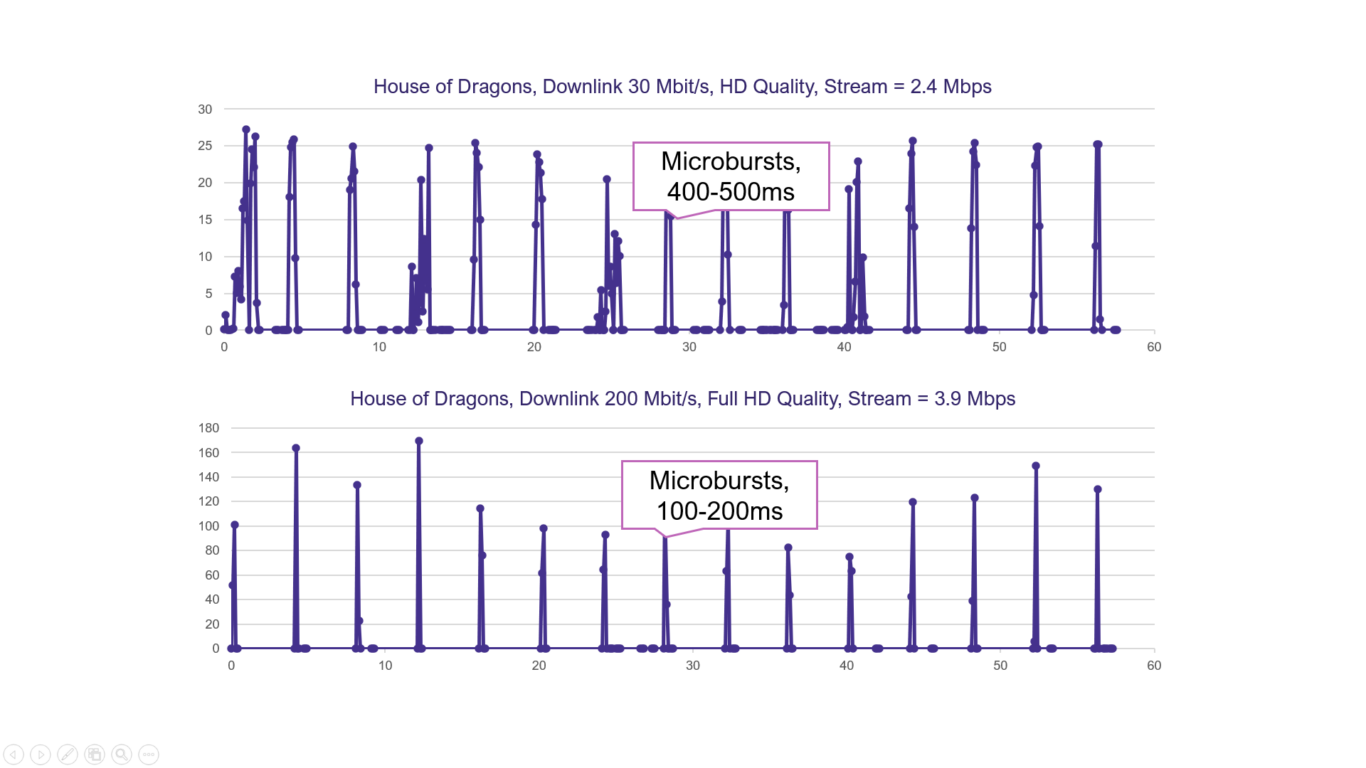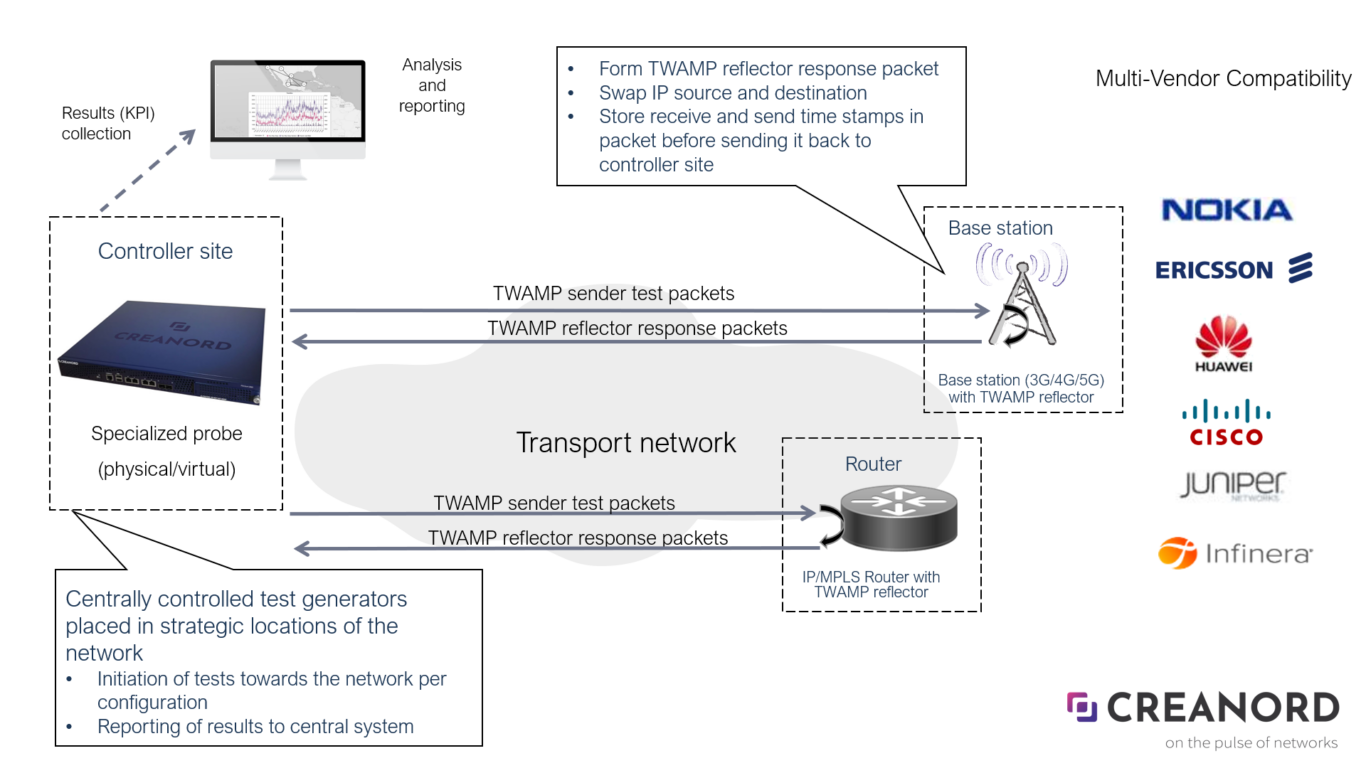An Introduction to Using the TWAMP Protocol for Active Monitoring of 5G Transport Networks

The competitive advantage for mobile network operators used to be coverage and speed. As mobile networks have matured, the focus has changed towards a more comprehensive view of the user experience. Studies show that the network is the top buying factor for roughly 40% of the users. It is also the biggest reason for churn. Nearly 40% of the users switch operators because of network quality issues.
Until now, operators have typically monitored the quality of their networks by collecting utilization information from the network using SNMP. As the utilization of a link gets close to 100%, you know that the capacity of the link must be upgraded. You can further add some insights to the performance by monitoring specific SNMP counters such as packet loss, which is also a clear indication that capacity of the link is too low as packets get dropped.
However, the introduction of 5G brings some new challenges that traditional methods like SNMP performance monitoring cannot deal with properly:
- Streaming Video. More than 70% of the traffic in the mobile network today is video. Streaming video is very bursty and the 5-minute averages typically reported by SNMP monitoring solutions are not capable of correctly capturing these bursts.
- New Critical Applications. New ultra-reliable and low-latency services are introduced in the network. These services rely on very short delays, stable jitter and no packet loss. SNMP monitoring tools are not able to capture these types of end-to-end service quality KPIs.
- Large number of services and service classes. A large number of new types of services and service classes are introduced in the 5G networks. End-to-end service quality KPIs must be captured for each of these service classes individually as they each have varying demands on jitter, packet loss and delay. Again, this is something that SNMP monitoring tools are not able to capture.
The picture below illustrates the challenging nature of adaptive bitrate streaming. Instead of a stable bitrate, there are regular bursts of traffic. Higher downlink speeds imply more bursty traffic.

Figure 1 Stream profiles for adaptive bitrate streaming
 Understand TWAMP Protocol better, read the article:
Understand TWAMP Protocol better, read the article:
End-to-End Performance Monitoring with the TWAMP Protocol
A new approach is needed to cope with these new challenges. The Two-Way Active Measurement Protocol (TWAMP) has been designed to meet the requirements of 5G transport performance monitoring. It was standardized more than 15 years ago in the IETF and TWAMP implementations on the market are robust and mature and widely supported by the major network element vendors. Major benefits of TWAMP are:
- Granularity. With centralized and dedicated TWAMP initiators, you can send out packets with a high frequency, typically every second or every 100 milliseconds to base stations and intermediate routers and you are thus able to capture microbursts at all locations in the network.
- Accuracy. The TWAMP protocol has better accuracy than the commonly used ICMP ping protocol since it has the possibility to eliminate processing delays in the reflector from the results. TWAMP reflection capability is easy to implement in network equipment and it is typically optimized to provide accurate timestamping. The TWAMP protocol itself has been designed so that processing delays at the reflectors can be subtracted from the results. With the TWAMP protocol it is possible to get microsecond-level accurate results.
- Multi-Vendor. The TWAMP protocol has been widely implemented in the network devices including both routers and base stations (gNB) from all the major vendors on the market. Thus, the capability for TWAMP measurements in the mobile networks is widely available, both end-to-end between core and base stations as well as for measuring the intermediate network segments.
 Take end-to-end to the next level! Continue reading:
Take end-to-end to the next level! Continue reading:
Creanord Releases High Performance TWAMP Reflector for End-to-End 5G Transport Network Monitoring
How to Efficiently Deploy Active TWAMP Monitoring for 5G Transport Networks
Equipment vendors typically provide both TWAMP initiators that send out TWAMP packets and collect the results as well as TWAMP reflectors that simply reflect the packet back at the remote end. It may therefore seem like an efficient and easy way to use the vendor functionality and element manager for the TWAMP monitoring. However, this approach has several drawbacks:
- No Multi-Vendor View. The equipment vendor’s element manager performs TWAMP monitoring only for the equipment vendor devices. In a 5G network, you typically have base stations and transport devices from multiple vendors. Thus, you will not have a complete view of the performance of the entire transport network. Also, troubleshooting performance issues is difficult as you need to consolidate the data from multiple element managers during the troubleshooting process.
- Lack of efficient reporting and analytics tools. The mobile and transport equipment vendors’ focus is on the 5G feature set and/or transport capabilities of the equipment and performance management is a second priority. Thus, the element managers provide very rudimentary and basic reports in the form of Excel reports or CSV files. For comprehensive visibility into the transport network performance, you need feature-rich and efficient analytics tools that help you solve complex network transport and application issues.
- Low scalability. Again, the mobile and transport equipment vendors’ focus is elsewhere than the scalability of the TWAMP solution. Thus, if you rely on the mobile or equipment vendor to provide the TWAMP initiator, you often have to stack multiple devices on top of each other in order to be able to support a sufficient number of measurements. This is both costly and complex to manage.
Fortunately, there is a better and efficient way to get a consolidated, end-to-end view of network performance across multiple vendors and domains. The solution is to deploy a few specialized probes at central core locations to measure performance with TWAMP towards the base stations and intermediate transport network elements. The specialized probes are controlled by an accompanying performance management system that manages all the measurements, collects the measurement results, and runs analytics, machine learning and AI methods to produce the needed consolidated reports for the different user groups.

Figure 2 Centralized TWAMP Active Monitoring for 5G Transport Networks
This approach has multiple benefits:
- Scalability. The specialized probes that have been designed particularly for TWAMP measurements have much better scalability than the devices offered by the mobile equipment vendor that include a lot of other functionality as well. Specialized TWAMP probes can easily handle up to hundreds of thousands of packets per second, so you only need a few at some core locations to cover the entire network rather than stacking multiple reflectors at each core site.
- Harmonized, multi-vendor view: Specialized probes take care of the performance monitoring for all different domains in the network and thus the analytics, machine learning and reports are applied to a consistent set of data regardless of the mobile equipment vendors. Monitored devices only need to implement simple TWAMP reflector functionality, which is available today in most of the network devices. All specialized logic and advanced analytics are done in the specialized probes and the associated performance management system, guaranteeing a harmonized set of results across different vendors’ devices.
- Segmented view: Using specialized TWAMP probes at central locations not only offers you the end-to-end view of network performance between the core and base station locations, but also offers the possibility to monitor the performance towards the intermediate routers and radio links along the path to the base station in order to segment the network performance view and find the segments that introduce most of the quality impairments. The segmented view of the network quality is important for efficient troubleshooting of performance issues.
- Cost-efficiency: To monitor a very large network, you only need to deploy a few specialized probes in central locations and use the built-in TWAMP reflector functionality in the monitored devices. With a centralized solution you have all data stored centrally in one system and get a harmonized view across the multiple vendors avoiding manual work to consolidate the reports. You also avoid having to do multiple integrations with higher level OSS systems as the centralized TWAMP solution also acts as a mediator towards the OSS systems offering a consolidated multi-vendor view of the network performance.
 Learn how to troubleshoot the trickiest networking issues:
Learn how to troubleshoot the trickiest networking issues:
Conclusions
The TWAMP protocol has become the de facto standard for mobile network performance monitoring. With the introduction of 5G it is more important than ever to understand the performance of your network in order to ensure that all the new traffic types get the performance they need. A centralized approach to perform monitoring is the best alternative in order to stay on the pulse of your network.
To learn more about how to build modern monitoring capabilities, you can read the mobile transport customer case study from our web site or download our Mobile transport performance monitoring solution brief.
Get better control of mobile transport performance monitoring
About Creanord
Creanord offers technology solutions for network performance measurements and quality assurance. Driven to turn data into outperforming networks, Creanord helps mobile operators, managed service and wholesale providers as well as critical communications providers to design, offer and deliver services with confidence.
With PULSure, service providers can track network performance and user experience in order to meet the most demanding service needs of their customers.
Since 2000 Creanord has served customers that offer the most demanding networks and applications making societies smarter, businesses more competitive and our lives safer.
Creanord is headquartered in Helsinki, Finland with a global operations and partner network.